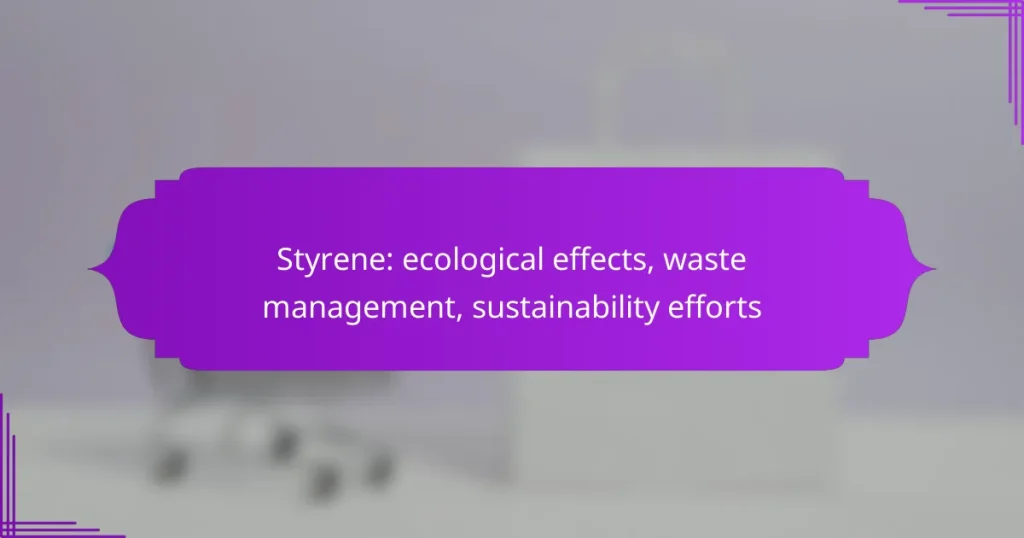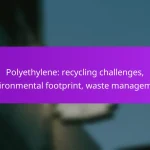Styrene has notable ecological effects, particularly in New Zealand, where it threatens marine ecosystems, air quality, and soil health. Effective waste management strategies, including recycling and adherence to disposal regulations, are essential to mitigate its environmental impact. Additionally, sustainability efforts are increasingly focused on reducing styrene’s footprint through alternative materials and regulatory initiatives, promoting safer practices in its production and use.
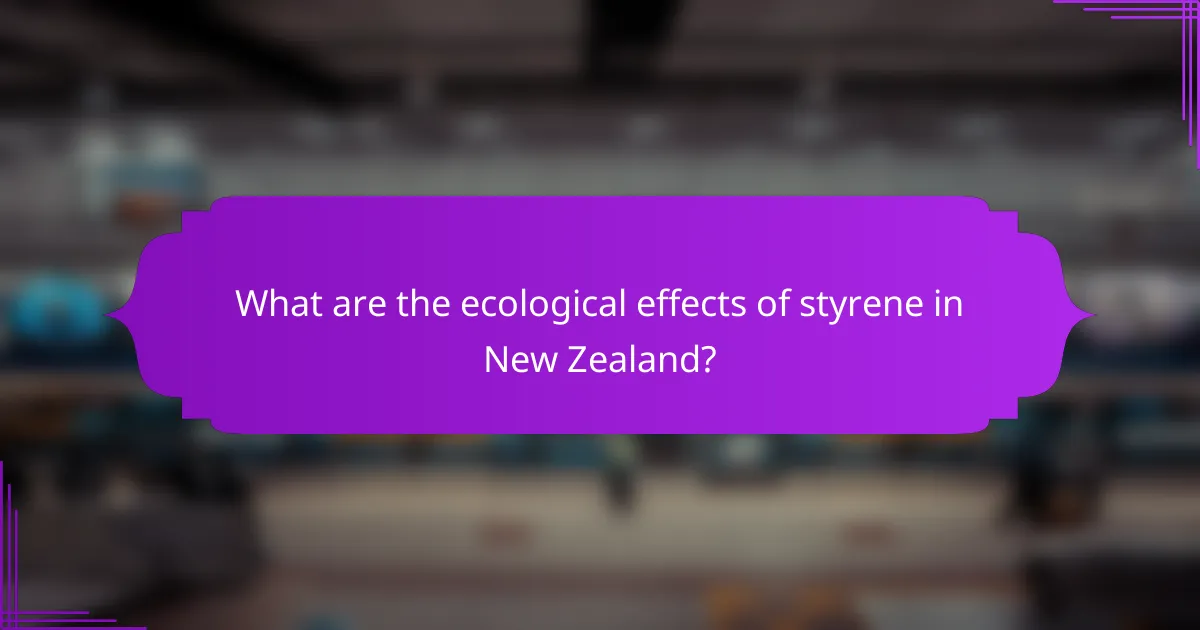
What are the ecological effects of styrene in New Zealand?
Styrene poses significant ecological effects in New Zealand, particularly impacting marine ecosystems, air quality, and soil health. Its presence can disrupt local wildlife and contribute to environmental degradation if not managed properly.
Impact on marine life
Styrene can adversely affect marine life through contamination of water bodies. Fish and other aquatic organisms may experience toxic effects, leading to reduced populations and biodiversity loss. Long-term exposure can disrupt reproductive systems and growth rates in sensitive species.
In New Zealand, areas near industrial sites or heavy shipping routes are particularly vulnerable. Monitoring programs are essential to assess the levels of styrene in marine environments and implement protective measures.
Air quality concerns
Styrene emissions can degrade air quality, posing health risks to both humans and wildlife. In urban areas, industrial activities can release styrene into the atmosphere, contributing to smog and respiratory issues. New Zealand’s air quality standards aim to limit such emissions, but compliance is crucial.
Residents near manufacturing facilities should be aware of potential air pollution and advocate for regular monitoring and stricter regulations to minimize exposure to harmful substances.
Soil contamination risks
Styrene can contaminate soil through spills or improper disposal of waste materials. This contamination can hinder plant growth and disrupt soil microbial communities, leading to long-term ecological damage. Remediation efforts may be necessary to restore affected areas.
In New Zealand, land management practices should prioritize the safe handling of styrene-containing products to prevent soil contamination. Regular soil testing can help identify and mitigate risks before they escalate.
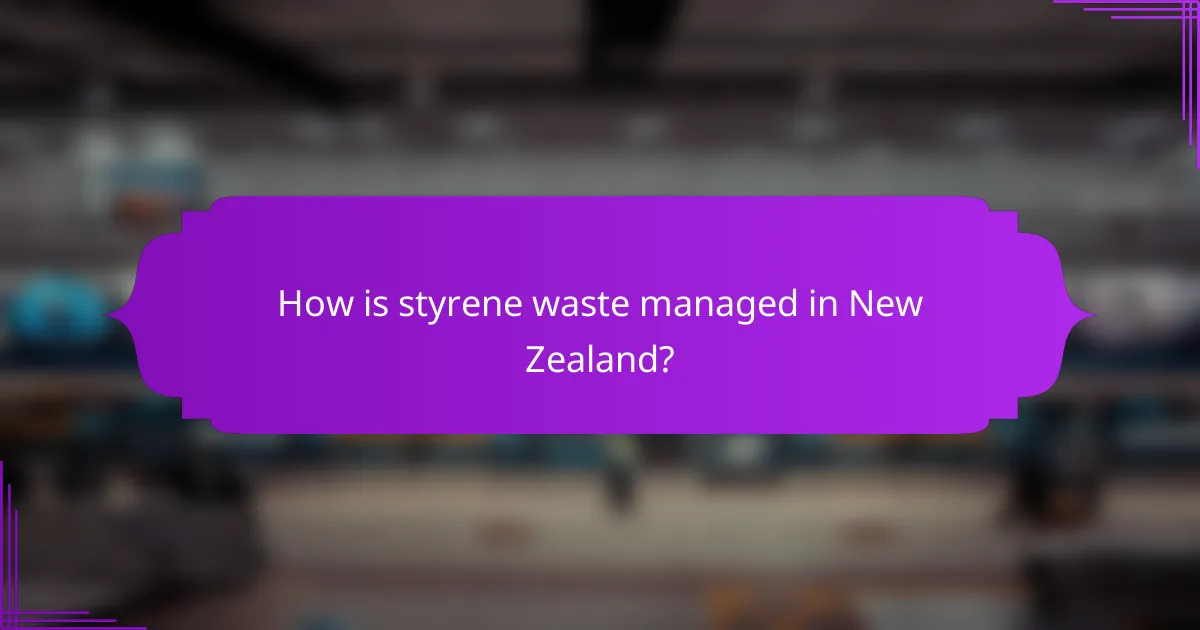
How is styrene waste managed in New Zealand?
In New Zealand, styrene waste management involves recycling, adherence to disposal regulations, and treatment of hazardous waste. These processes aim to minimize environmental impact while ensuring public safety and compliance with local laws.
Recycling processes
Recycling of styrene in New Zealand primarily focuses on reclaiming polystyrene, a common form of styrene. Facilities often use mechanical recycling methods to process clean, uncontaminated polystyrene waste into reusable materials.
Some companies are exploring advanced recycling technologies, such as chemical recycling, which can convert polystyrene back into its monomer form, allowing for a more sustainable lifecycle. However, the availability of these facilities is still limited.
Disposal regulations
Disposal of styrene waste in New Zealand is governed by strict regulations to protect the environment. The Waste Minimisation Act requires businesses to manage waste responsibly and encourages the reduction of styrene waste at the source.
Landfill disposal is generally discouraged for styrene products due to their potential to leach harmful chemicals. Instead, businesses must follow guidelines set by the Environmental Protection Authority (EPA) for proper disposal methods.
Hazardous waste treatment
Styrene is classified as a hazardous substance, necessitating careful treatment to mitigate risks. Facilities that handle styrene waste must comply with the Hazardous Substances and New Organisms Act, ensuring safe storage and disposal practices.
Common treatment methods include incineration and specialized chemical processes that neutralize harmful components. Companies are encouraged to work with certified hazardous waste management providers to ensure compliance and safety.
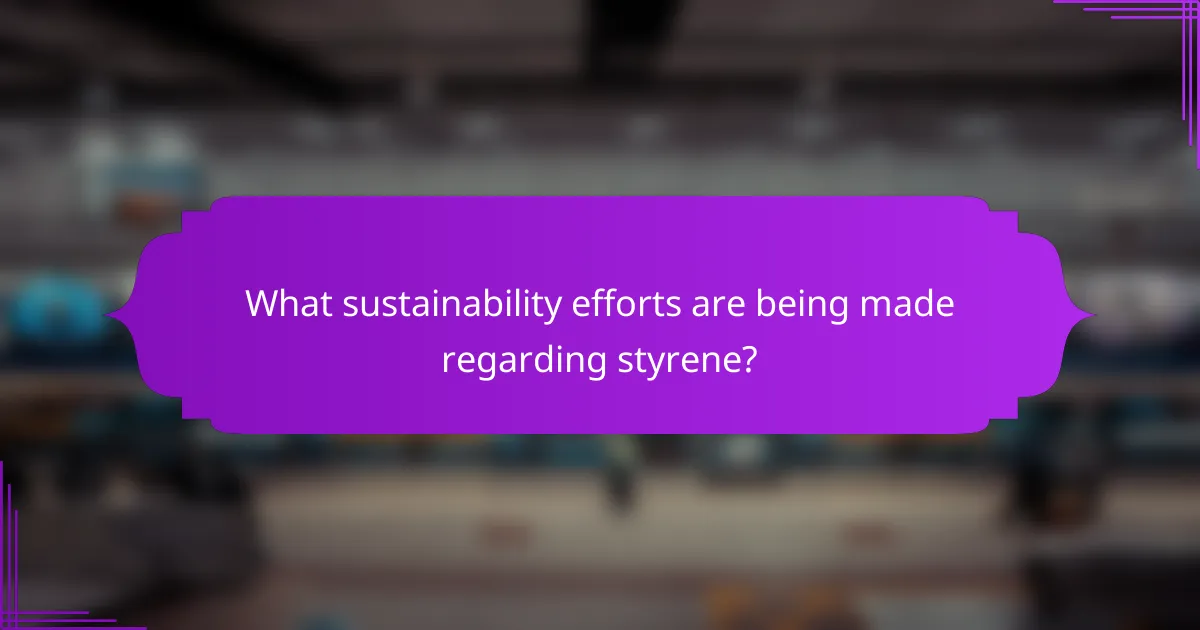
What sustainability efforts are being made regarding styrene?
Sustainability efforts regarding styrene focus on reducing its environmental impact through alternative materials, industry initiatives, and government regulations. These approaches aim to minimize styrene’s ecological footprint while promoting safer and more sustainable practices in its production and use.
Alternative materials development
Research into alternative materials is a key sustainability effort in reducing reliance on styrene. Biodegradable polymers and bio-based composites are being developed as substitutes, which can lower the environmental impact associated with traditional styrene products. For example, polylactic acid (PLA) and other plant-derived materials are gaining traction in various applications.
Companies are increasingly exploring the use of recycled materials to replace styrene in manufacturing processes. This not only conserves resources but also reduces waste, contributing to a circular economy. The transition to these alternatives often involves collaboration between manufacturers, researchers, and environmental organizations.
Industry initiatives for reduction
Many industries are implementing initiatives to reduce styrene emissions and improve sustainability. This includes adopting cleaner production technologies that minimize styrene release during manufacturing. For instance, some companies are investing in advanced filtration systems and closed-loop processes to capture and reuse styrene.
Additionally, industry groups are promoting best practices for styrene handling and disposal. These initiatives often involve training programs for workers and guidelines for safe usage, which help mitigate risks associated with styrene exposure and environmental contamination.
Government policies on styrene
Government policies play a crucial role in regulating styrene use and promoting sustainability. Many countries have established guidelines that limit styrene emissions and set safety standards for its use in consumer products. For example, the European Union has stringent regulations under REACH (Registration, Evaluation, Authorisation, and Restriction of Chemicals) that govern styrene’s use and encourage safer alternatives.
In addition, governments are providing incentives for companies to adopt greener practices, such as tax breaks for those investing in sustainable technologies or research. These policies not only help protect the environment but also stimulate innovation in the development of alternative materials and processes.

What are the health risks associated with styrene exposure?
Exposure to styrene can pose several health risks, particularly affecting the nervous system and respiratory functions. Short-term exposure may lead to immediate symptoms, while long-term exposure can result in more severe health issues, including chronic conditions.
Short-term health effects
Short-term exposure to styrene can cause a range of acute symptoms. Individuals may experience headaches, dizziness, and fatigue shortly after inhalation or skin contact. Other symptoms can include irritation of the eyes, skin, and respiratory tract, which may lead to coughing or difficulty breathing.
In some cases, high levels of styrene exposure can lead to more severe reactions, such as nausea or vomiting. It is crucial to minimize exposure in occupational settings by using proper protective equipment and ensuring adequate ventilation.
Long-term health risks
Long-term exposure to styrene is associated with more serious health risks, particularly concerning the central nervous system. Chronic exposure may lead to cognitive impairments, including difficulties with memory and concentration, as well as mood disorders.
Additionally, there is evidence suggesting that prolonged styrene exposure may increase the risk of certain cancers, particularly in occupational settings where exposure levels are higher. Regulatory agencies recommend monitoring and controlling styrene levels in workplaces to mitigate these risks effectively.

What are the best practices for styrene waste management?
Effective styrene waste management involves proper segregation, safe storage, and community engagement. Implementing these best practices minimizes environmental impact and promotes sustainability in handling styrene waste.
Segregation of waste streams
Segregating styrene waste from other types of waste is crucial for effective management. This practice ensures that hazardous materials are treated appropriately and reduces the risk of contamination. For instance, separate containers should be used for styrene-based products, such as packaging and residual materials.
It is advisable to label waste containers clearly to prevent cross-contamination. Using color-coded bins can also help workers quickly identify the correct disposal method, enhancing compliance with local regulations.
Safe storage guidelines
Storing styrene waste safely is essential to prevent leaks and exposure. Waste should be kept in well-ventilated areas away from direct sunlight and heat sources, as styrene is flammable. Containers must be made of compatible materials to avoid chemical reactions.
Regular inspections of storage areas are necessary to check for leaks or deterioration. Establishing a routine maintenance schedule can help identify potential issues early, ensuring compliance with safety standards.
Community awareness programs
Raising community awareness about styrene waste management is vital for fostering responsible practices. Educational programs can inform the public about the risks associated with improper disposal and the benefits of recycling styrene materials.
Engaging local organizations and schools in workshops can enhance understanding and encourage participation in waste reduction initiatives. Providing resources, such as brochures or online materials, can further support community efforts in managing styrene waste effectively.
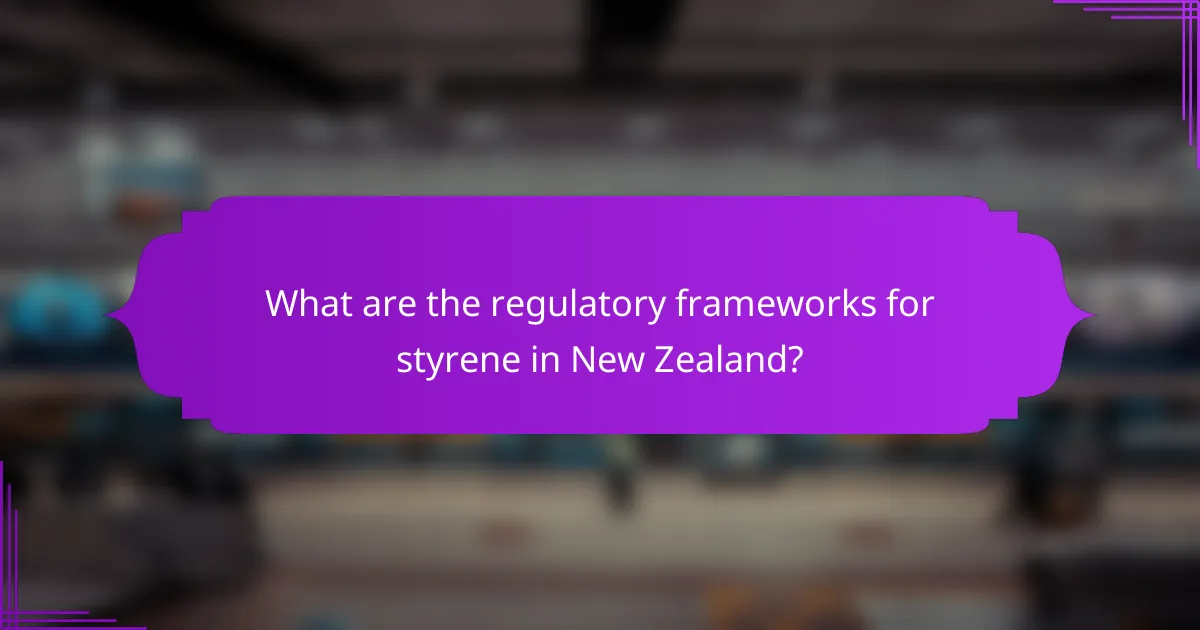
What are the regulatory frameworks for styrene in New Zealand?
In New Zealand, the regulatory frameworks for styrene focus on environmental protection and workplace safety. These frameworks ensure that styrene is managed responsibly to minimize its ecological impact and safeguard public health.
Environmental Protection Authority guidelines
The Environmental Protection Authority (EPA) in New Zealand sets guidelines for the use and management of styrene to mitigate its environmental effects. These guidelines include assessments of styrene’s potential impacts on air, water, and soil quality.
Companies handling styrene must conduct environmental impact assessments and adhere to best practices for waste disposal. Regular monitoring and reporting are essential to ensure compliance with EPA standards.
Health and Safety at Work Act compliance
Under the Health and Safety at Work Act, employers must ensure a safe working environment when handling styrene. This includes providing appropriate training, personal protective equipment, and implementing safety protocols to minimize exposure risks.
Employers should conduct risk assessments to identify potential hazards associated with styrene use and establish emergency response plans. Regular health monitoring for workers exposed to styrene is also recommended to prevent long-term health issues.
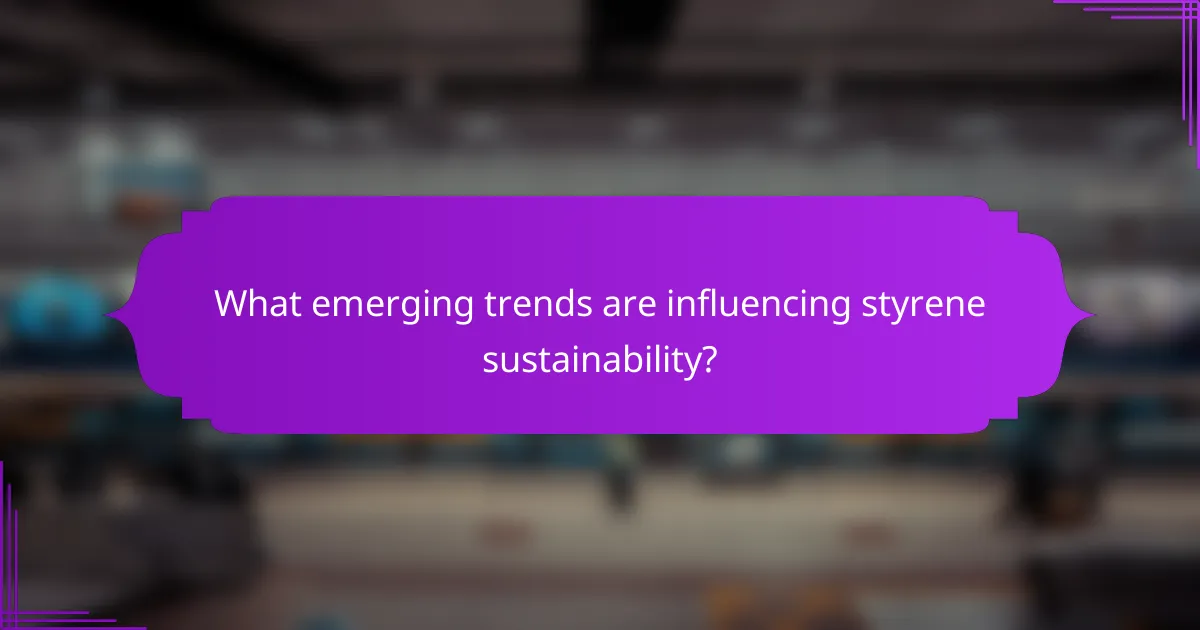
What emerging trends are influencing styrene sustainability?
Emerging trends in styrene sustainability focus on reducing environmental impact through innovative recycling methods, alternative materials, and regulatory changes. These trends aim to minimize styrene waste and enhance the overall sustainability of styrene production and use.
Advancements in recycling technologies
Advancements in recycling technologies are crucial for improving styrene sustainability. New methods, such as chemical recycling, allow for the breakdown of styrene-based plastics into their original monomers, making it possible to reuse them in production. This process can significantly reduce the need for virgin materials and lower carbon emissions.
Companies are increasingly investing in these technologies, which can lead to a circular economy for styrene products. For instance, some facilities are now capable of recycling polystyrene, a common styrene polymer, into high-quality raw materials for new products.
Shift towards bio-based alternatives
The shift towards bio-based alternatives is another trend influencing styrene sustainability. Researchers are exploring plant-derived materials that can replace traditional styrene sources, reducing reliance on fossil fuels. These bio-based options can offer similar properties while lowering the carbon footprint of production.
Examples include using renewable resources like sugarcane or corn to produce styrene-like compounds. This transition not only supports sustainability but also aligns with consumer demand for eco-friendly products.
Regulatory changes and industry standards
Regulatory changes and industry standards are shaping the landscape of styrene sustainability. Governments are implementing stricter regulations on styrene emissions and waste management, pushing companies to adopt more sustainable practices. Compliance with these regulations often requires investment in cleaner technologies and processes.
For instance, the European Union has set ambitious targets for reducing plastic waste, which directly impacts styrene production. Companies that proactively adapt to these regulations can enhance their market position and appeal to environmentally conscious consumers.
